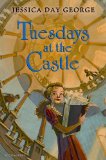Gearing Up for the Morris Seminar and ALA Midwinter Meeting
I’m so excited! Four years ago, the Association for Library Service to Children announced it would be starting the William Morris Seminar: A biennial invitational training in book evaluation skills, run by people who have selected past Newbery, Caldecott, Odyssey, Geisel, and other award winners.
I applied that time, but didn’t get accepted. I applied two years ago, but didn’t get accepted. I applied this time and did! So will I let a little thing like iffy health after a stroke stop me from attending? No, I will not!
But now it’s getting down to the wire. The seminar is this coming Friday, in Dallas, and as soon as it is over, ALA Midwinter Meeting begins. I have today off, but I will be working tomorrow and Wednesday. Wednesday night, I have to go to a “Senior Night” for parents at my son’s school. I believe they are mainly collecting money! But also some information will be given out, and I need to fill out some forms and drop off a toddler picture of my son. Then I leave on Thursday.
In the meantime, I also really need to get the FAFSA and CSS Profile paperwork done for my son’s financial aid applications. Because if I wait until after the seminar, the time will be too short. Better do it today, but I do find myself definitely procrastinating.
On a more fun note, I should go over again the books on our discussion list. I’ve read them all, but I should look at them afresh in terms of discussing their distinguished qualities. I think I will interrupt my reading plans to reread Okay for Now after I finish Death Comes to Pemberley and take notes for discussion.
Then there’s the matter of packing. I am sure I will have plenty of chances to pick up books to read once the conference starts on Friday. But what to read on the plane? What to read Thursday night? I may well have finished rereading Okay for Now by then. The next item on my 2012 Reading Plan is an Award Winner. I was going to read Please Ignore Vera Dietz, but I don’t like to bring hardcover library books on trips. So instead, I think I’ll go further down the list and read Everybody Sees the Ants, also by A. S. King, which is a 2011 Cybils Finalist, and which I have as a paperback ARC. After that, my plan says I read a prepublication ARC, so I think I will tuck in Drowned Cities, by Paolo Bacigalupi. Since I’m also bringing Okay for Now for the Morris Seminar, and since I will have plenty of opportunities to pick up new books, that will surely be plenty to bring. The big question is, can I really stop with those three? We shall see….
Of course another huge highlight of ALA Midwinter is the Youth Media Awards announcements on Monday morning. In the past, I’ve followed those on the internet, so it will be a thrill to be there in person, especially having discussed possibilities in detail at the Morris Seminar.
Another thing that makes me happy about ALA Midwinter is that I’ve already connected with some friends who will be there. I’ve only officially been a Librarian for four years, so I am very happy to already have some good friends in the library world. I’ve made them via Twitter, blogs, KidLitCon, our local DC KidLit book club, and other ALA events, and these are people who are also interested in great books for children. It feels very good to feel part of this world and have actual friends I’m excited to see and some to meet in person for the first time. Oh, and on top of that, my writing buddy is going to come for the weekend and share my hotel room. We met in Paris and she is a wonderful vivacious and encouraging person, and I’m so excited to get some time with her.
Of course, on top of all that, I’d really like to get my 2011 Stand-outs page posted! And all the reviews written for the books I chose. We shall see. This day off is already getting out of hand. And did I mention that on top of all of it, I’ve caught a cold? Oh, and I finally have an appointment with my neurologist — the day after I come back — to find out if I had another stroke some time in December. At least that way he won’t have the chance to tell me not to go!
Speaking of my neurologist, I was proactive and got a note from him to allow me to bring a rolling cart onto the exhibit floor. Since every single e-mail about the conference ends with the admonition: “No rolling carts are permitted on the exhibit floor!” I hope that this note will give me an exception. At ALA last summer, I knew my shoulder and neck seemed to be hurting extra from carrying a heavy bag of books, but I didn’t realize I’d had a vertebral artery dissection and was probably making it worse. Now I’m going to stick to my guns and insist on that cart.
I’ve already had two different dreams about ALA Midwinter! In one, I met Brian Selznick and was discussing why I think his book is fabulous as a whole, but I don’t think the text or illustrations on their own are distinguished enough to win (though I would be happy enough if I’m wrong). In the next, I was at an SCBWI Conference, happily picking up free books. I must be excited!






